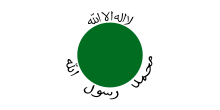Somali National Movement
| Somali National Movement (SNM) | |
|---|---|
| Participant in Somali Civil War | |
 | |
| Ideology | Anti-communism |
| Groups | Isaaq |
| Leaders |
Sheikh Yusuf Ali Sheikh Madar
Colonel Abdiqadir Kosar Abdi
|
| Headquarters | Dire Dawa, Hargeisa |
| Area of operations |
|
| Became |
|
| Allies | United Somali Congress |
| Opponents | Somali National Army |
The Somali National Movement (Somali: Dhaq dhaqaaqa wadaniga soomaliyeed, Arabic: الحركة الوطنية الصوماليه) was a 1980s–1990s Somali rebel group. The Somali National Movement was organized in London, England, on April 6, 1981 by Hasan Adan Wadadi, a former Somali diplomat, who stated that the group's purpose was to overthrow the Siaad Barre regime.[3] The SNM gathered its main base of support from members of the Isaaq clan, who formed and supported the movement in response to years of systematic discrimination by the Siaad Barre government.The SNM at first did not necessarily support secession, The USC's announcement of a provisional government in February 1991 angered the SNM who maintained that they had not been consulted. Pressure for secession evidently came from the SNM's followers, who were devastated by the loss of lives and the destruction of northern cities by the Siad Barre government. In Hargeisa, for instance, only 5% of the city's buildings remain standing.[4]
Formation
In April 1981, a group of Isaaq dissidents living in east London (Whitechapel) formed the Somali National Movement (SNM), and at the end of 1981 it was announced in London, which subsequently became one of the Somalia's various insurgent movements. According to its spokesmen, the rebels wanted to overthrow Saaid Barre's dictatorship.
Somali Civil War
The SNM succeeded in overrunning several government outposts in Northern Somalia. The SNM-USC-SPM unification agreement failed to last after Siaad Barre fled Mogadishu. On January 26, 1991, the USC formed an interim government, which the SNM refused to recognize. On May 18, 1991, the SNM declared the northwestern Somali regions independent, establishing the Republic of Somaliland. The USC interim government opposed this declaration, arguing instead for a unified Somalia. Apart from these political disagreements, fighting broke out between and within the USC and SPM.
Somaliland
The SNM was extremely influential in the establishment of Somaliland, a self-declared sovereign state that is as an autonomous region of Somalia.[5] Many former SNM members are the key in the formation of the government and constitution.
References
- ↑ http://www.alnef.org.za/conf/2010/presentantions/somalia.pdf
- ↑ Tekle, ed. by Amare (1994). Eritrea and Ethiopia : from conflict to cooperation (1. print. ed.). Lawrenceville (N.J.): the Red sea paper. p. 150. ISBN 0932415970.
- ↑ Helen Chapin Metz, Somalia: a country study, Volume 550, Issues 86-993, (The Division: 1993), p.xxviii.
- ↑ Lacey, Marc (June 5, 2006). "The Signs Say Somaliland, but the World Says Somalia". New York Times. Retrieved February 2, 2010.
- ↑ The UK Prime Minister's Office Reply To The "Somaliland E-Petition"